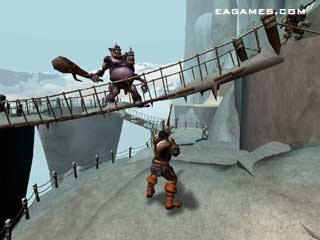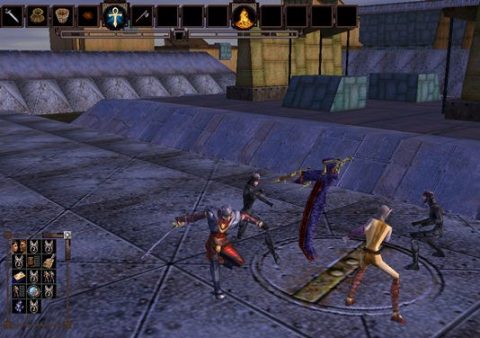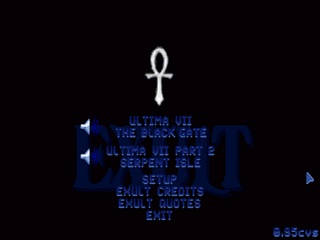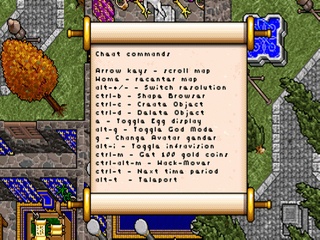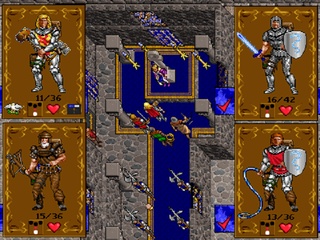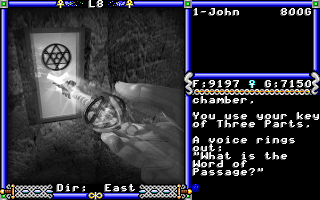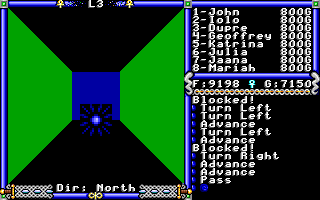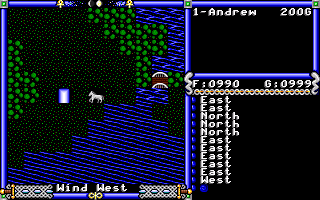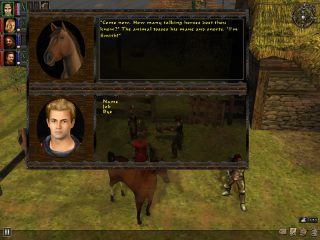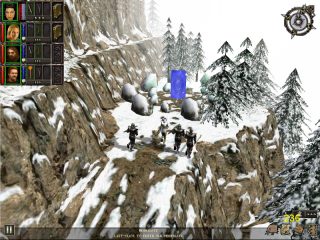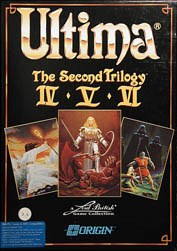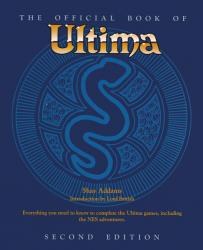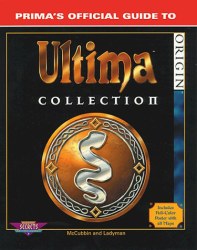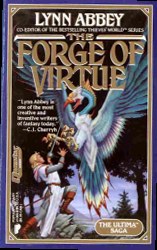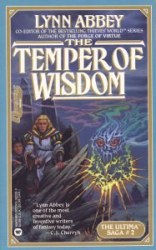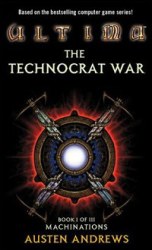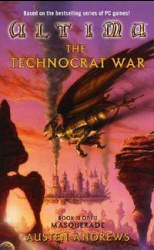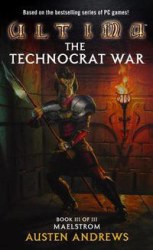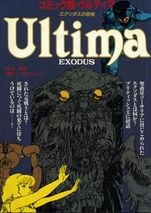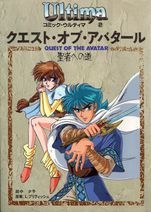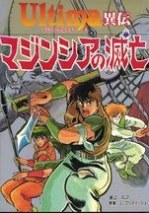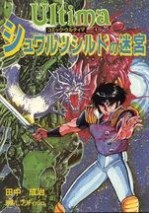- Ultima (Series Introduction)
- Akalabeth
- Ultima I: First Age Of Darkness
- Ultima II: Revenge of the Enchantress
- Ultima III: Exodus
- Ultima IV: Quest Of The Avatar
- Ultima V: Warriors of Destiny
- Ultima VII: The Black Gate
- Ultima VI: The False Prophet
- Ultima VII Part 2: Serpent Isle
- Ultima VIII: Pagan
- Ultima Underworld: The Stygian Abyss
- Ultima Underworld II: Labyrinth of Worlds
- Arx Fatalis
- Worlds of Ultima: The Savage Empire
- Ultima Worlds of Adventure 2: Martian Dreams
- Ultima IX: Ascension
- Lord of Ultima
- Ultima Online
- Ultima: Escape from Mt. Drash
- Ultima: Miscellaneous
- Richard Garriott (Interview)
Cancelled Games
Probably the most anticipated game in this section, Ultima Online 2, sequel to the smash hit UO, was canceled in 2001. The game world was to be an alternate Sosaria, created by a failed attempt by Lord British to rebuild the Gem of Immortality and a resulting cataclysm that mixed the past, present and future of Sosaria into a single world; this premise is rather like the world of Ultima II: Revenge of the Enchantress. The game would have used a fully 3D engine, taken place in a world where medieval technology, the industrial age and the space age combined, and changed several aspects of Ultima Online that fan feedback had shown dislike for. Among additions, the game would have emphasized a grouping mechanic where players are encouraged to band together rather than try to become all-powerful individuals; players of modern MMORPGs refer to this as “raiding”, and UO2 would have done it years before certain modern MMORPGs popularized it. A trilogy of tie-in novels, The Technocrat War series by Austin Andrews, was completed and published to promote the game; the game itself did not follow suit.
Ultima X Odyssey was scheduled to be released sometime in 2004, a new Ultima MMORPG that was marketed as continuing the story of the main series, which left off on the disappointing Ultima IX: Ascension. Odyssey was the first Ultima game to be designed and planned after Richard Garriott left the company, and the second Ultima MMORPG to be canceled, one of a number of other online games that Electronic Arts slashed around the same time, including notably Warhammer Fantasy Online (which would be revived in 2005). The official reason given for this was a desire to ‘focus efforts on Ultima Online‘, but that was just corporate talk. The real reason seems to be a simple matter of logistics: Electronic Arts wanted to move the Origin team to a new location in California, leaving behind Austin which had been Origin’s home for years. In the pre-broadband internet era this no doubt seemed like a rational (if short-sighted) business decision to the EA biz guys, who we are going to assume do not have families, only spawn formed in their piles of money. The Origin team didn’t want to go. Since things could not be reconciled, Electronic Arts simply dissolved the company.
Odyssey would have used the much-lauded Unreal engine, and included the established Britannian virtue system as a game mechanic, including the ability to achieve Avatarhood by maxing out their affinity with each virtue; to this end, the game would have included missions with ethical choices to be made, much like the scenarios presented in character creation in previous Ultima games. The game would have had a very distinctive art style and quite a bit of concept art has been released.
There was also a third Worlds of Ultima title called Worlds of Ultima: Arthurian Legends planned, with the Avatar questing in the time of King Arthur and the Knights of the Round Table. Arthurian Legends would have used the more recent Ultima VII engine rather than the Ultima VI engine used for the two previous Worlds of Ultima games. Designer Sheri Graner Ray claims that the primary design phase was complete and quite a bit of the map work and character art had been finished, and quest design had begun. It seems to have been canceled due to the lukewarm sales of The Savage Empire and Martian Dreams, though the idea to use Ultimaengines to create new games fortunately didn’t die with it, with System Shock based on Ultima Underworld and the Crusader series based on Pagan being released in the ’90s.
Mythos was another game planned by Origin to use the Ultima VI engine, which would have involved a combination of the ancient Greek legends with the golden age of piracy in the Caribbean. This was planned before Savage Empire and Martian Dreams were developed and seems to have never gotten past the concept stage (the only real source of information on Mythos is in the first edition of Shay Addam’s Book of Ultima). Fan speculation is that the ideas floated for Mythos eventually formed the basis of the original, non-Ultima Serpent Isle.
In 2005 Ultima: 25th Anniversary Edition, a compilation of Ultima games, was planned but shelved for unknown reasons. The pet project of Ultima historian Stephen Emond, the 25th Anniversary Collection would have included XP-compatible versions of all Ultima games ever released to that point (except the two Runes of Virtuegames and Mount Drash), a history book, a soundtrack CD, a complete atlas, and replicas of the various feelies from the original releases; whether this means all PC Ultimas or all versions of Ultima with attendant C64, Apple II etc. emulators is uncertain. It seems that EA had no real interest in completing the project, as it was originally intended for November 2005, then pushed to January 2006, and then canceled. The only evidence of this collection now is an image of the game box, and an unreleased advertisement designed by Emond showing the same box as well as the box of a Wing Commander 15th Anniversary Collection of similar scope. Given how the most complete existing collection of Ultima games excludes Ascension as well as the fantastic Underworld and Worlds of Ultima series entirely, it’s a shame this collection never saw daylight.
A canceled, unnamed project with the working title Multima was being worked on by Origin sometime around 1987-1988. It was Origin’s first attempt at an online multiplayer game and would have beaten Stormfront’s Neverwinter Nights to ‘first graphical MUD’ by a few years. In development by James Van Artsdalen (who at the time was primarily employed with porting Origin games to PC and Macintosh), the game would have allowed from eight to sixteen players to join a single game. Eventually the focus shifted from a Ultima-style RPG to something like a strategy game, each player a Lord controlling a territory and competing with other players. GEnie (General Electric’s online service) may have been negotiating with Origin for publishing rights to the game around this time. There’s not terribly much clear information available otherwise, and the game was canceled for unknown reasons and never discussed after 1988.
Other projects of far less exposure (and even lesser likelihood that they went past the planning stage) include: Ultima Reborn, a Nintendo DS game; Ultima Resurrection, a Sony PSP game; Ultima IV: Part 2, a planned stopgap game between Ultima IV and V, and various proposals for Ultima Underworld III. There’s little to suggest any of these games ever got past the “Hey, wouldn’t this be a neat idea?” part of development; in the case of UUW3, this is a terrible disappointment to Paul Neurath, who was pushing for a third Underworld game to be made for many years. Interestingly, it seems that at one point Origin was considering hiring John Romero’s startup Ion Storm to work on a third Underworld; Mr. Romero declined, being busy with Ion Storm’s other projects at the time.
Source Ports, Fan Patches, Collections
One of the most beloved, devotion-inspiring series in gaming history, Ultima has seen a landslide of fan work over the years, from upgrades and unofficial patches to engine source ports, mods for other games, and total remakes of the games from the ground up. Downloads for these and a more complete listing can be found at Ultimaaiera. Some of the most important of them are:
Exult
Exult is the largest, most complete and most far-reaching Ultima fan project. First released for the X Windows System, a GUI for unix-based operating systems, Exult has received official and unofficial ports to numerous systems. The project is a complete source port written in C++ of the Ultima VII engine, allowing people who own the data files for The Black Gate, Forge of Virtue, Serpent Isle and The Silver Seed to play the games on multiple modern operating systems.
There’s a few reasons why Ultima VII was worthy for the treatment. For starters, even on actual DOS machines it’s finicky to get Ultima VII games to run, and impossible on Windows 9.X and above machines, due to the nature of the Voodoo memory manager written for the games by Origin. On 16-bit computers like the ones Ultima VII was written for, it is physically impossible to access all of the memory that the game demands, requiring a special memory manager, but on 32-bit systems, the memory manager breaks. For another, the Complete Ultima VII has long been the favorite installment of the series of RPGers, computer gamers and Ultima fans for the sheer complexity and quality of the games, which built on every Ultima that came before without venturing into experimental territory as Pagan and Ascension did.
Exult as of the latest release works pretty much identically to the original games, with everything the Ultima VIIengine had implemented and 100% compatibility with all four Ultima VII products. In addition it includes several improvements, including more keyboard shortcuts, a new game option menu, the addition of Serpent Isle paperdoll inventories in The Black Gate, extra save game slots, middle-button mouse support, extremely high resolutions, improved audio, and several others. Many Ultima fans have created mods for Ultima VII using Exultas well, including a Keyring mod that adds that useful item into The Black Gate as well as several other improvements, an unofficial Serpent Isle patch, the Serpent Isle in French project, and several (aborted) remakes of The False Prophet. Aside from DOSBox, Exult is the best way to play these games by far; they even include settings for an authentic experience that sets Exult to play indistinguishably from the DOS original.
Exult is open-source and released under the GNU GPL, so if you’re an Ultima fan with C++ skills, they probably have a problem or two they’d appreciate you solving, or an abandoned port that needs finishing. It seems quite a few people would appreciate someone implementing Serpent Isle’s original extended intro, as well. The source port is available for for BSD, Linux, Mac OS X, PocketPC, Sony PSP, Microsoft Xbox 360, GP2X, Dingoo, Symbian OS, Android, Android Java, Amiga OS/MorphOS, Zaurus and probably others as well. The officially-supported platforms are Linux, Mac OS X, OpenBSD, FreeBSD, and Windows (9X through 7); other ports are in various states of completion and activity. Exult is included as bundled software in many free distributions of Unix-based systems, such as Debian and FreeBSD.
The latest main focus of the Exult development team seems to be a standalone game engine for making entirely original games, titled Exult Studio. Other members of the Exult team and people inspired by Exult‘s success have also founded offshoot projects to create the same sort of source port program for the Ultima VIand Ultima VIII engines: these projects are called respectively Nuvie and Pentagram, and aren’t quite as complete as Exult but getting there.
Links:
Exult official project page
Exult Studio
Nuvie project page
Pentagram project page
xu4: Ultima 4 Recreated
First released as an alpha in 2002 but with much development work since, xu4 was written by Andrew Taylor and Darren Janeczek, and is a source port of Ultima IV to various platforms including Windows, Linux, Mac OS X, Zaurus, BeOS, Sega Dreamcast and others. The goal seems to have been to create an Ultima IV that played as close to the original as possible, with the advantage of modern system compatibility and a mess of configuration and customization options. As of 2011 the program seems to be essentially complete and bug-free.
In particular, xu4 allows you to select from a number of different graphical tilesets to play Quest of the Avatar in, including EGA, two different VGA sets, the FM Towns graphics, and others. xu4 allows a great deal of control over the technical aspects of the game, including various timing tweaks, as well as adding useful hotkeys to take some of the bite out of more tedious tasks. As well, the music is modified to use better instruments than Windows’ standard GS Wavetable MIDI or the MIDI included in Dosbox, and the music sounds light-years superior to any other version of Ultima IV. The audio upgrade’s quality cannot be stressed enough.
While Quest of the Avatar works perfectly well in DOSBox and even has a fine 256-color VGA fan upgrade to make it the superior 16-bit version of Ultima IV, xu4 is better. This, right here, is the definitive Quest of the Avatar, and anybody picking up the game from the Ultima Anniversary website or Gog.com is well advised to play in xu4.
Links:
xu4 project homepage
Ultima V: Lazarus
Most ambitious mods for games fizzle out sooner rather than later. Either the people working on it don’t have the time, or lose interest, or the game engine becomes dated as development drags on and technology advances. This makes Lazarus all the more impressive; a complete, enhanced, updated remake of Warriors of Destiny using Gas-Powered Games’ Dungeon Siege engine.
The scale of Lazarus is enormous. Several members of the team are professional game designers – the project director, for instance, is Big Huge Games’ Ian Frazier. In Lazarus, the entire Britannia of Ultima V is recreated in 3D, with all-new models, high-quality character portraits and newly remastered CD-quality music. The tale of Blackthorn’s usurpation of Lord British is told in fine style with visuals that rival Ascension.
Lazarus improves and adds to Warriors of Destiny in multiple ways, with expanded dialogue, additional quests, more flavorful NPCs, and the addition of features from other Ultima games such as Serpent Isle style dialogue portraits, an Ultima VII style dialogue system, and much-expanded Resistance and Oppression factions that have a far greater effect on the game world. Lazarus includes 3D introduction, cutscene and ending movies created by the team, and adds additional player choice in the possibility of taking an ‘evil’ story path where the Avatar sides with the Shadowlords, helping Blackthorn’s Oppression and trapping Lord British in the underworld forever. Some things couldn’t be included in Lazarus due to engine limitations, such as the spells to travel up or down a level in the dungeon, but these are minor.
Lazarus is not a stand-alone game: it uses the Dungeon Siege engine and operates as a mod, so an installed and working copy of Dungeon Siege is required in order to play. The game looks utterly fantastic, and is essentially a whole new, unofficial and professional-quality Ultima game.
Links:
Ultima V: Lazarus official page
Lazarus fiction
Lazarus mods, patches and downloads.
Ultima Collections, Books, Other
Game Compilations
Plastic bag release by California Pacific Computer Co. of Ultima and Akalabeth: World of Doom for Apple II. Two 5.25″ disks and reprinted documentation.
Ultima Trilogy, 1989
Collects the first three games of the series, the Age of Darkness. Released for Apple II, C64, PC and FM Towns on 5.25″ disk. The FM Towns version, released by Fujitsu in 1992, is a special edition CD that includes colorful remakes of the games as well as introduction movies with impressive painted artwork. Game includes new Trilogy manual and cardboard map.
Ultima: The Second Trilogy, 1992
Collects the next three games in the series, the Age of Enlightenment. Released for Apple II, C64, PC and FM Towns in both 3.5″ and 5.25″ disk versions. Game includes new Trilogy manual and cardboard map.
Ultima I-VI Series, 1993
CD-ROM re-release by Electronic Arts of the previous two Trilogy collections. Includes the contents of the previous two compilations including new collection manuals, and three cardboard maps. Ultima II is broken and several outer-space maps do not work.
The Complete Ultima VII, 1993
CD-ROM re-release by Electronic Arts of all four Ultima VII engine games: The Black Gate, Serpent Isle and both expansions. Includes the original documentation from the games and cloth maps. First North American Ultima release on CD-ROM. Later re-released under the EA Gold Classics label.
Ultima Underworld, 1993
CD-ROM re-release by Electronic Arts of both Ultima Underworld games, including the original documentation, paper maps and latest patches. Later re-released under the EA Gold Classics label.
Ultima Collection, 1998
The best collection package available in North America, the Ultima Collection is a CD released to drive up hype for the impending release of Ultima IX: Ascension. It contains Ultima I through VII (Ultimas I-VI are the same versions previously released on the Trilogy disks, and Ultima II is therefore broken), a program called MoSlo to allow the games to be slowed to a playable speed on a Windows 9.X machine, full electronic versions of all documentation for the games as well as walkthroughs written by Origin employees, and a series of interview videos with Richard Garriott. This same disk was included in the special Dragon Edition of Ultima IX. Mild disappointment for fans in that it did not include either Worlds of Ultima or Underworld game. Later re-released under the EA Gold Classics label.
The Genesis of Ultima, 1999
Released exclusively in Japan by Locus, this is a fan-written hint book for various Ultima Games that included a CD-ROM with disk images of Ultima I-IV and Akalabeth’s Apple II versions, as well as an Apple II emulator. It’s not clear whether this is an authorized product, but the games and emulator are almost certainly taken off the internet and used without permission of the copyright-holder.
Ultima: Best of Both Worlds Edition, 2000
A combination package of Ultima IX: Ascension and Ultima Online’s second expansion, Renaissance, in a very large box with disappointing lack of original documentation.
Ultima Complete, 2001
The most complete available compilation of Ultima games; unfortunately, the games are in Japanese and was released only in Japan. Includes the Japanese Ultima Collection, Ultima IX, and Ultima Online: Blackthorn’s Revenge. Also includes some unique trinkets such as a Britannian coin and a Britannia Citizenship certificate.
Ultima Online: 7th Anniversary Edition, 2004
Commemorative package containing the Ultima Online: Age of Shadows expansion and the entire Ultima IX: Ascension in final patched (1.18f) form, with a ‘fan guide’, paper map of the Malas continent introduced in the UO expansion, and no original documentation.
There are likely ones besides these, but they’re going to be fairly obscure. More information on the various Ultima releases can be had by visiting the Ultima Collector’s Guide.
Ultima Books & Novels
Ultima has had a large selection of literature associated with it, even beyond the outstanding writing work done in making the manuals that come with each game. All of these books are long out of print and there are no plans to republish any of them any time soon, though the novels by Lynn Abbey and Austen Andrews are fairly easy and inexpensive to come by via online bookstores.
Clue Books:
Ultima III Clue Book: Secrets of Sosaria, by Robert Garriott
Ultima IV Clue Book: The Way of the Avatar, by author unknown.
Ultima V Clue Book: Paths of Destiny, by author unknown
Ultima VI Clue Book: The Book of Prophecy, by David “Dr. Cat” Shapiro
Ultima VII Clue Book: Key to the Black Gate, by Andrew Morris
Serpent Isle Clue Book: Balancing the Scales, by Sheri Graner Hobbs and Andrew Morris
Ultima VIII Clue Book: Pentology, by Melissa Mead
The Savage Empire Clue Book: Malone’s Guide to the Valley of Eodon, by Aaron Allston
Martian Dreams Clue Book: The Lost Notebooks of Nellie Bly, by Beth Miller
Ultima Underworld Clue Book: Mysteries of the Abyss by Aaron Allston
Ultima Underworld II Clue Book: Gems of Enlightenment, by Austin Grossman
The various clue books written by Origin for their Ultima games are unique in that they follow the same conceit that game manuals do: they are written as in-universe books, narrated by characters from the games. Pentology, the clue book for Ultima VIII, for instance, is written as a lecture from Remvatos, the demigod son of the Pagan God of Balance Apathas, guiding the Avatar through the perils of Pagan by providing ‘not strength, but wisdom’. Each cluebook includes additional artwork, including some that didn’t make it into the games or their manuals, as well as additional insight into the characters and worlds of the games. The two cluebooks for the Ultima Underworld games are particularly notable about this, filling in plenty of background detail and information that goes unstated either in-game or in the manuals as well as providing some impressive artwork not found elsewhere. Most of these cluebooks can be downloaded on Replacementdocs.com.
Ultima Books & Novels
The Official Book of Ultima, by Shay Addams
The most comprehensive piece of research on the Ultima series, including both a history of Richard Garriott and Origin Systems, an in-depth look at the development of The False Prophet, as well as walk-throughs of all released Ultima games up to that point in time. In 1992 a second edition was released containing most original content from the first edition, as well as help for The Black Gate, The Stygian Abyss, The Savage Empire, Martian Dreams and several of the NES games. Unfortunately, no similar or more complete version of this book has been released since 1992 and nobody else seems keen to write one, meaning that a comprehensive single history for the entire Ultima series doesn’t really exist anywhere in published form outside of Stephen Emond’s out-of-print Collector’s Guide.
Master Ultima: Mystery, Magic and Strategy, by Ralph Roberts
Published by SAMS in 1991, this contains walkthroughs and general hints and strategies for Ultimas I through VI. The chapters for each game are presented in two formats: a straightforward walkthrough and an in-universe account of each adventure told as a narrative story. The book also includes some information on Ultima’s history, an FAQ about Richard Garriott, and a brief Britannian glossary.
Ultima: The Avatar Adventures, by Rusel DeMaria and Caroline Spector
Ultima: More Avatar Adventures, by Caroline Spector
Published by Prima Books, the first volume in this series covers the Age of Enlightenment games and the second covers Ultima Underworld: The Stygian Abyss and Ultima VII: The Black Gate. These books are walkthroughs written as novels, in the form of journal entries by the Avatar narrating his adventures in Britannia; they are presented in the context of historical artifacts being researched by Britannian historians who debate their authenticity. Creative stuff, all told. These books contain a number of character details not suggested by the games and of uncertain canonicity (the Avatar having a crush on Jaana, for instance), and include lengthy interviews with Richard Garriott, Paul Neurath and Warren Spector about their games.
Ultima VIII Pagan: The Ultimate Strategy Guide, by Joe Hutsko and Raymond Lueders.
Published by Prima Publishing, this is an alternative to the official Origin hint book for Pagan, containing a walkthrough, charts, tables, maps and illustrations. The book was released prior to Pagan’s patching and so some differences between the guide and the final game exist.
Prima’s Official Guide to Ultima Collection, by Chris McCubbin and David Ladyman
Released alongside the Ultima Collection disk, this book consists primarily of reprinted material from other guides, including the Origin hint books and Ultima: The Avatar Adventures, with original sections written for Akalabeth and Ultima I and II. It also includes a full-color glossy poster containing images of all the Ultima cloth maps, reprinted in full color. It isn’t quite a complete collection of the Origin hint books, but it seems to be close to one. Unfortunately, no material for either Underworld or Worlds of Adventure game is included.
Prima’s Official Guide to Ultima IX: Ascension, by Chris McCubbin and David Ladyman
More Ascension than you ever needed, including background on Britannia, charts, maps, a full game walkthrough, a simplified walkthrough presented in the form of the Avatar’s journal, and a full-color poster of the Tapestry of Ages depicting the stories of every Ultima in a huge collage. But the most useful part of this book is an almost 50-page marathon interview with Richard Garriott, discussing the Ultima series as a whole, the history of Origin, and multiple other topics of value to Ultima fans. The interview is partially a reprint of the Richard Garriott interview in Ultima: The Avatar Adventures, but includes much new and updated material. In addition? This is the only book in this section that you can find for under five dollars on the aftermarket rather than almost a hundred. Grab em’ before word spreads.
Ultima Exodus NES Hint Book, by author unknown
Published in 1989 in the US by FCI, the publisher of the Nintendo console Ultimas, this hint book includes full-color maps and a game walkthrough of Exodus, as well as all attendant necessary extras like graphs and charts. The first few pages of this book are a graphic novel done by an unknown artist (in the style of Katsuya Terada’s work for The Legend of Zelda and Nintendo Power, though it’s not terribly likely he’s the one who drew it), depicting the plots of Ultima and Ultima II, which never received Nintendo ports. No similar hint books were released for the remaining Nintendo Ultima ports, which instead received expanded-size manuals containing much the same cluebook information.
Origin’s Official Guide to Ultima Online, by Tuesday Frase and Melissa Tyler
Released in 1997 as a companion guide to Ultima Online, containing all the information you’d expect in a strategy guide. The book’s information on many topics is, however, long out of date due to the release of multiple expansions, patches and updates since 1997. There were three additional cluebooks published as expansions to this book for The Second Age, Lord Blackthorn’s Revenge and Age of Shadows.
Ultima Collector’s Guide, by Stephen Emond
What probably would have filled the demand for a comprehensive guide to the entire series after the Book of Ultima failed to ever update past 1992, the Collector’s Guide is a gigantic, 700+ page work full of release info on the different games in the series. Unfortunately, Mr. Emond could not find a publisher for the book that offered agreeable terms, and it only exists now as a manuscript and in three hand-made copies. He is currently seeking alternative means to publish the work. You can read a sample here.
The Ultima Saga, by Lynn Abbey and Richard Garriott
1991: The Forge of Virtue
1992: The Temper of Wisdom
A series of original novels written by Lynn Abbey with creative input from Richard Garriott and published by Questar Fantasy, taking place in Britannia just before and during the reign of Lord Blackthorn and the Shadowlords. The book’s official plot summaries say it best:
“Four young adventurers: Lord Ironhawk’s son Jordan Hawson, beautiful Althea, a headstrong blacksmith named Drum, and Jordan’s kid brother Squirt heed a mystic globe’s dark warning to find Balthan, Althea’s magician brother. It is a quest that will take them through the perils of trolls, harpies, and gypsies until they discover the mission is far more crucial than they ever imagined. A vast evil has sunk its claws into Britannia. Lord British’s ruling Council of Mages is in hiding, its members marked for death. And only the elusive Balthan knows the truth behind it all.” -The Forge of Virtue
“Jordan Hawson and his companions return to Hawksnest only to receive a bitter welcome: their home has been tainted by the same evil they confronted and escaped in the northern forests. Even Jordan’s father, Lord Ironhawk, is in the thrall of the corrupt inquisitor Lohgrin. With Jordan blind and disheartened, the Inquisitor moves swiftly and without opposition. Magician Balthan is condemned as a traitor, young Squirt becomes a fugitive in his own home, but the worst befalls Althea. The beautiful young woman will become Lohgrin’s bride unless her friends find within their hearts the will and courage to free themselves from the Inquisitor’s malignant sorcery.” -The Temper of Wisdom
Lynn Abbey has sample chapters of the books available on her official website.
The Technocrat War, by Austin Andrews
Book 1: Machinations
Book 2: Masquerade
Book 3: Maelstrom
A three-part trilogy of novels written from 2001 to 2002, Austin Andrews’ Technocrat War Trilogy was created to tie-in to the in-development Ultima Online 2 and is based on that game’s story. From the plot summary:
“A sorcerous cataclysm has remade the ancient and magical world of Sosaria, where a misguided plan to bring ultimate order to the land has altered its destiny forever. Now past, present, and future are one…a unity that sets in motion an astonishing age of discovery and conflict for this strange new world. Once separated by time and space, the warlike Juka, the calculating Technocrats, the matriarchs of the Meer, and the Virtuous knights of New Britannia are now on a collision course. Fragile alliances threaten to unravel as treachery and deceit pit kingdom against kingdom. Unless bitter enemies can put aside their vengeful differences long enough to uncover the truth, all Sosaria will be ripped asunder.”
These books received unusually good reviews from both gamers and fantasy fans. Andrews has published the first chapter of each book as a free preview, but his website is down as of this writing.
Ultima Manga
Circa 1988-89 when Pony Canyon/FCI was publishing Japanese editions of the Ultima games, Japanese book publisher JICC released four full-length manga series loosely inspired by the games’ stories. (Anybody familiar with Japanese comics will understand what ‘loosely’ means in this context). In addition to these, Ultima also appeared in short stories and comics in a variety of different Japanese magazines due to the wild popularity of Japanese-flavored western fantasy in Japan in the late ’80s and early ’90s, a popularity that was largely inspired by Ultima and Wizardry.
JICC No. 1: Ultima: The Terror of Exodus
Wherein Exodus is reimagined as a Lovecraftian cosmic horror (because an IBM 709 isn’t interesting enough, apparently) and called upon to defeat him are a hotshot space fighter pilot from the future, a psychic amazon, Anime John Lennon and a steam-powered robot.
JICC No. 2: Ultima: Quest of the Avatar
Wherein a young Paladin is called upon to a quest of Honor, to discover what happened to his vanished older brother who sought to become Avatar. Features mirror-universe versions of several Companions with swapped personalities and genders, including teenage girl Iolo and Shamino the pratfalling comic relief.
JICC No. 3: Ultima: The Fall of Magincia
Wherein Britannia’s seafarers are under attack by the prideful sorceror Vitor of Magincia, and a pirate captain and young, female version of Sentri join forces to stop him. Also Katrina is here and hears voices from God telling her to build an Ark for some reason.
JICC No. 4: Ultima: The Maze of Schwarzschild
Wherein random German because German is Japan’s default “foreigner” nationality and who knows what’s going on in this. If someone wants to translate, the Ultima Dragons at Ultimaaiera want to hear from you.
Links:
Scans and images of some of the Ultima comics.
Includes links to plot summaries and further reading.
Ultima Anime
There’s little information on this anime, and the sole information that seems to be available is a one-page web article written in Finnish, so this section is entirely speculation and not to be taken as a citable source of facts.
It seems that sometime in the late ’80s (1989?) TV Osaka had created a one-episode straight to video cartoon based on Ultima: Exodus in order to promote the release of the NES/Famicom port of the game and the recently-released NES Quest of the Avatar. For unknown reasons it seems like the anime was never shown on television nor actually sold on tape. It’s possible, however, that a television ad for Ultima: Exodus aired in Japan may include images from the Ultima anime; screenshots of this ad show a cute, childish anime cleric, the same one from the Exodus Famicom box art, and a closeup of her chest and hips. Sigh, Japan.
The only evidence of the show’s existence is a few tapes found in the wreckage of a TV Osaka warehouse destroyed in the 1995 Kobe earthquake. The tapes of the show were discovered after having been lost for many years; it seems the studio’s inventory list made no mention of them. No video of the anime has ever made it to the internet, nor any screenshots of it running, and it’s not clear where those tapes are now. Possibly they may have been part of an auction of old TV Osaka material meant to help victims of the earthquake, which at 6.8 was quite severe and caused Japan a great deal of damage.
Another potentially more believable explanation is that it was simply a small bit of animation created specifically for a television commercial. The text scroll at the bottom of each screen reads off its features (2 megabits of ROM with battery backup, and so forth), with would certainly indicate that it’s an advertisement.
Links:
The only known source of info on the Anime on the entire internet; in Finnish.
